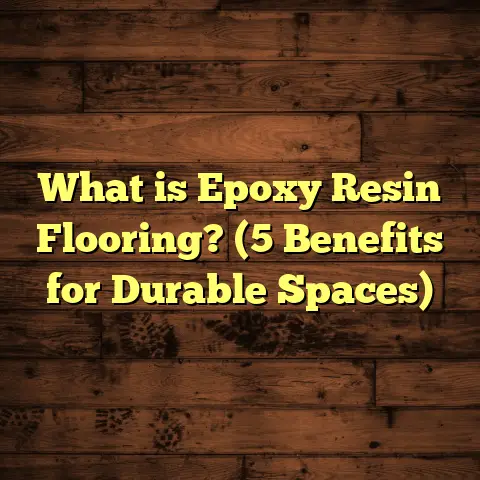What is Character Grade Flooring? (5 Key Benefits Explained!)
When I’m called in to help with flooring projects, especially when time is tight and the client wants something that’s both stylish and practical, character grade flooring often comes up as a favorite choice. It’s one of those options that strikes a great balance between beauty and budget, while bringing a lot of personality to a space. If you’ve ever walked into a room and admired the wood floors that seem alive with their natural knots and streaks, chances are you were looking at character grade flooring—even if you didn’t know it.
You might be wondering exactly what character grade flooring is, how it compares to other types of hardwood, and why it’s so popular. I’ll share everything I’ve learned over years of projects—from the basics to the benefits, to how I use tools like FloorTally to plan costs efficiently. Plus, I’ll back it all up with real-world data, stories from my work, and some comparisons to help you decide if it fits your needs.
What is Character Grade Flooring?
At its core, character grade flooring is hardwood flooring that includes the natural imperfections of wood instead of hiding or removing them. When lumber is milled into flooring planks, the wood is graded based on its appearance. Character grade falls somewhere between “clear” or “select” grade hardwood—which is very uniform and free of knots—and lower utility grades that might be too rough or damaged for typical flooring.
The natural features you see in character grade wood—knots, mineral streaks, small cracks, color variations—are all part of the wood’s story. These are not defects; they’re characteristics that add depth and warmth. For me, this makes every plank feel unique. No two boards look exactly alike, which isn’t the case with higher-grade wood that’s selected for uniformity.
The grading system comes from the National Hardwood Lumber Association (NHLA), which sets clear guidelines on how wood is sorted based on visual quality. Character grade wood often carries classifications like “#2 Common” or “#3 Common,” meaning it contains more visual interest but still meets strength and durability standards for flooring.
I remember one project where a homeowner wanted a floor that didn’t feel “perfect” or sterile. They loved the idea of something more organic and lived-in. Character grade oak was perfect for their open-plan kitchen and living room because it gave the floor personality without sacrificing quality.
How Do You Identify Character Grade Flooring?
You can spot character grade flooring by looking for:
- Knots: These circular or oval marks where branches once grew are common and vary in size.
- Color Variation: Boards might have light and dark patches or mineral streaks.
- Grain Patterns: More pronounced grain lines with swirls or waves.
- Small Checks or Cracks: Occasionally present but typically stable and filled during finishing.
- Insect Markings or Sapwood: Sometimes visible in character grade wood for added uniqueness.
Unlike clear grade floors that are almost flawless with a smooth, consistent look, character grade embraces these traits to give a more natural feel.
5 Key Benefits of Character Grade Flooring
I’ve installed and worked with character grade flooring for years. Here are five big reasons why I keep recommending it:
1. Authentic Natural Beauty That Tells a Story
What keeps me coming back to character grade flooring is how it showcases wood’s natural charm. Each knot or streak isn’t a flaw—it’s part of what makes the floor alive and authentic. If you appreciate materials that feel genuine rather than factory-perfect, this will resonate.
There’s something special about seeing the age rings in a knot or the subtle color shifts that come from the tree’s life cycle. These details make walking on the floor feel like connecting with nature every day.
One memorable client told me their character grade pine floor reminded them of their grandparents’ farmhouse. It wasn’t fancy or polished but full of warmth and history—and they loved that feeling in their new modern home.
2. Cost-Effective Without Compromising Strength
Character grade flooring tends to be less expensive than clear or select grades because more of the wood can be used without discarding boards for aesthetic reasons. That means you get solid hardwood at a better price point.
Based on my recent projects and supplier quotes, here’s what I’ve found:
| Flooring Type | Material Cost (per sq ft) | Labor Cost (per sq ft) | Total Cost Approximate |
|---|---|---|---|
| Clear Grade Oak | $8–$10 | $3–$5 | $11–$15 |
| Character Grade Oak | $6–$7 | $3–$5 | $9–$12 |
| Engineered Hardwood | $4–$7 | $3–$5 | $7–$12 |
Using character grade oak saved my clients about 20-30% on materials compared to clear grade oak without sacrificing durability. This makes it a smart choice when budget is tight but you want real wood.
3. Durability That Withstands Daily Life
Even though character grade wood includes knots and natural marks, don’t mistake these for weak points. The wood itself remains strong, and knots are usually tight and stable.
I installed character grade hickory in a busy family home where rough play was daily. After four years, the floor still looked fantastic with no structural issues—just some minor surface scratches that added even more character.
The dense grain structure of many species used in character grade flooring contributes to excellent durability. Species like oak, hickory, and maple hold up well even when used in high-traffic areas.
4. Masks Wear and Tear Better Than Clear Grades
This is one benefit I find invaluable for families or busy spaces: character grade floors naturally disguise scratches and dirt thanks to their varied colors and marks.
I’ve seen many clear grade floors show every scratch right away because of their uniform light color and smooth surface. Meanwhile, character grade floors hide wear better because the eye has more natural texture to focus on.
This can reduce stress around pets running inside or kids dropping toys—and means your floor stays looking great longer between cleanings or refinishes.
5. Fits Many Design Styles Perfectly
It’s a misconception that character grade works only in rustic or countryside homes. I’ve used it successfully in modern urban apartments, industrial lofts, coastal cottages—you name it.
The key is choosing the right species and finish. For example:
- Light-stained character maple works beautifully in minimalist spaces.
- Darker walnut with knots brings warmth to traditional or transitional rooms.
- Matte finishes keep the look natural rather than glossy.
By mixing these options thoughtfully, you can get a floor with unique texture that complements almost any decor style.
How I Use FloorTally to Manage Flooring Costs
Estimating costs accurately can be tricky when working with variable materials like character grade hardwood. That’s why I rely heavily on FloorTally during planning stages.
FloorTally allows me to enter room dimensions, material choices (including species and grades), labor rates based on my region, and even waste factors—usually around 7-10% for hardwood—to get precise budget estimates.
Before FloorTally, I spent hours collecting quotes from suppliers and contractors separately. Now, I get consolidated numbers quickly that help me advise clients honestly on what fits their budget.
For instance, if a client wants character grade walnut but worries about cost overruns, I can adjust waste factors or labor assumptions right there to keep estimates realistic. It saves time and reduces surprises during installation.
Real-World Case Studies & Data
Case Study 1: Family Home Hardwood Flooring Upgrade
- Location: Suburban Midwest
- Floor Size: 1,200 sq ft
- Material: Character grade white oak
- Cost: $7 per sq ft materials + $4 per sq ft labor
- Waste factor: 8%
The family wanted durable floors with warmth but couldn’t stretch budget for clear grade oak. The character grade option delivered rich tones with knots that added charm without breaking the bank.
After two years, they reported satisfaction with how well the floor hides pet scratches and daily wear. The slight variations in wood color have deepened nicely over time, adding even more appeal.
Case Study 2: Urban Loft Renovation
- Location: Downtown city apartment
- Floor Size: 800 sq ft
- Material: Character grade maple
- Cost: $6 per sq ft materials + $5 per sq ft labor
- Waste factor: 10%
This client wanted something modern but warm underfoot. We chose character-grade maple with a low-sheen finish to keep it natural yet sleek.
The variety in grain and knots gave a beautiful texture contrasting with minimalist furniture. The floor has held up well against urban foot traffic and occasional spills thanks to proper finishing.
Comparing Character Grade Flooring to Other Options
I often get asked how character grade hardwood compares to alternatives like clear grade hardwood, engineered wood, laminate, and vinyl plank flooring. Here’s what I tell clients after years of hands-on experience:
Character Grade vs Clear Grade Hardwood
If you want flawless wood with minimal variation, clear grade is your pick—but expect to pay significantly more. Clear grades are excellent when you want a smooth, polished look without natural markings.
Character grade offers a more rustic or authentic feel with natural imperfections but at a better price point. Both have the same strength if well installed; it just depends on your aesthetic preference.
Character Grade vs Engineered Hardwood
Engineered hardwood uses a thin veneer over plywood layers to resist moisture. It’s often chosen for basements or kitchens where solid hardwood might warp.
While engineered hardwood can be less expensive upfront, it usually can be refinished fewer times than solid hardwood floors like character grade wood. If you want longevity and authentic thick wood planks full of character marks, go solid hardwood.
Character Grade vs Laminate Flooring
Laminate is synthetic flooring that mimics wood appearance using photographic layers over fiberboard core.
Laminate resists scratches well and costs less but lacks the warmth and texture of real wood grain knots found in character grade flooring.
If you want the tactile feel of real wood underfoot with natural markings, laminate won’t deliver that experience.
Character Grade vs Vinyl Plank Flooring
Vinyl plank floors are waterproof and very low maintenance but are plastic-based products designed to look like wood.
They are great for wet areas but don’t have the natural grain patterns or authentic feel of wood floors with knots and mineral streaks found in character grade hardwood.
More Thoughts from My Projects: Why I Keep Choosing Character Grade Wood
Over time I’ve realized something important: people don’t just buy floors; they buy feelings attached to those floors. With character grade flooring, I see clients connect emotionally with their choice because it feels honest and lived-in rather than artificial.
One client once told me how her character grade pine floor reminded her of family holidays in old countryside homes—something she wanted her own kids to experience even in a modern setting.
On another project, I noticed how contractors appreciated working with character grade lumber because its imperfections didn’t demand perfectionism—allowing faster installation without worrying about hiding minor flaws.
From a maintenance standpoint, I’ve learned that clients love how well these floors age. Unlike clear grades where every scratch feels obvious, character grade floors develop unique patinas that add personality rather than detract from value.
Technical Details: Installation Tips for Character Grade Floors
Because character grade wood includes natural variations in density (due to knots), installation requires some extra care:
- Acclimation: Like all hardwoods, allow planks to acclimate in your home for at least 72 hours before installation.
- Moisture Control: Ensure subfloor moisture levels are within recommended ranges for solid hardwood.
- Nailing/Stapling: Use appropriate fasteners as knots can be harder than surrounding wood.
- Finishing: Consider matte or satin finishes that highlight grain texture rather than gloss which might emphasize imperfections.
- Expansion Gaps: Leave proper expansion gaps around room edges as solid wood expands/contracts seasonally.
Following these steps helps ensure your character grade floor performs well long term without surprises due to its natural features.
Final Thoughts: Is Character Grade Flooring Right for You?
If you want a floor that feels natural, tells a story through its textures, holds up well under heavy use, and fits within a reasonable budget—character grade hardwood deserves serious thought.
From my personal experience working on different kinds of projects—family homes, urban apartments, rental properties—it consistently delivers value beyond just looks: durability, ease of maintenance, design flexibility—all wrapped in authentic wood beauty.
Tools like FloorTally help me manage costs carefully so clients get realistic budgets upfront without surprises later on. This means choosing character grade doesn’t mean risking unknown expenses; instead, it’s an informed decision backed by data.
Before deciding on any flooring type, ask yourself:
- Do I want perfect uniformity or natural variation?
- How much wear will my floors endure?
- What style am I aiming for?
- What budget am I comfortable with?
Character grade flooring ticks all these boxes for many people I work with—and maybe it will for you too.
If you want me to help calculate costs or give advice on installation specifics based on your project details, just ask! I’m always happy to share practical tips from the field so your flooring journey goes smoothly every step of the way.





